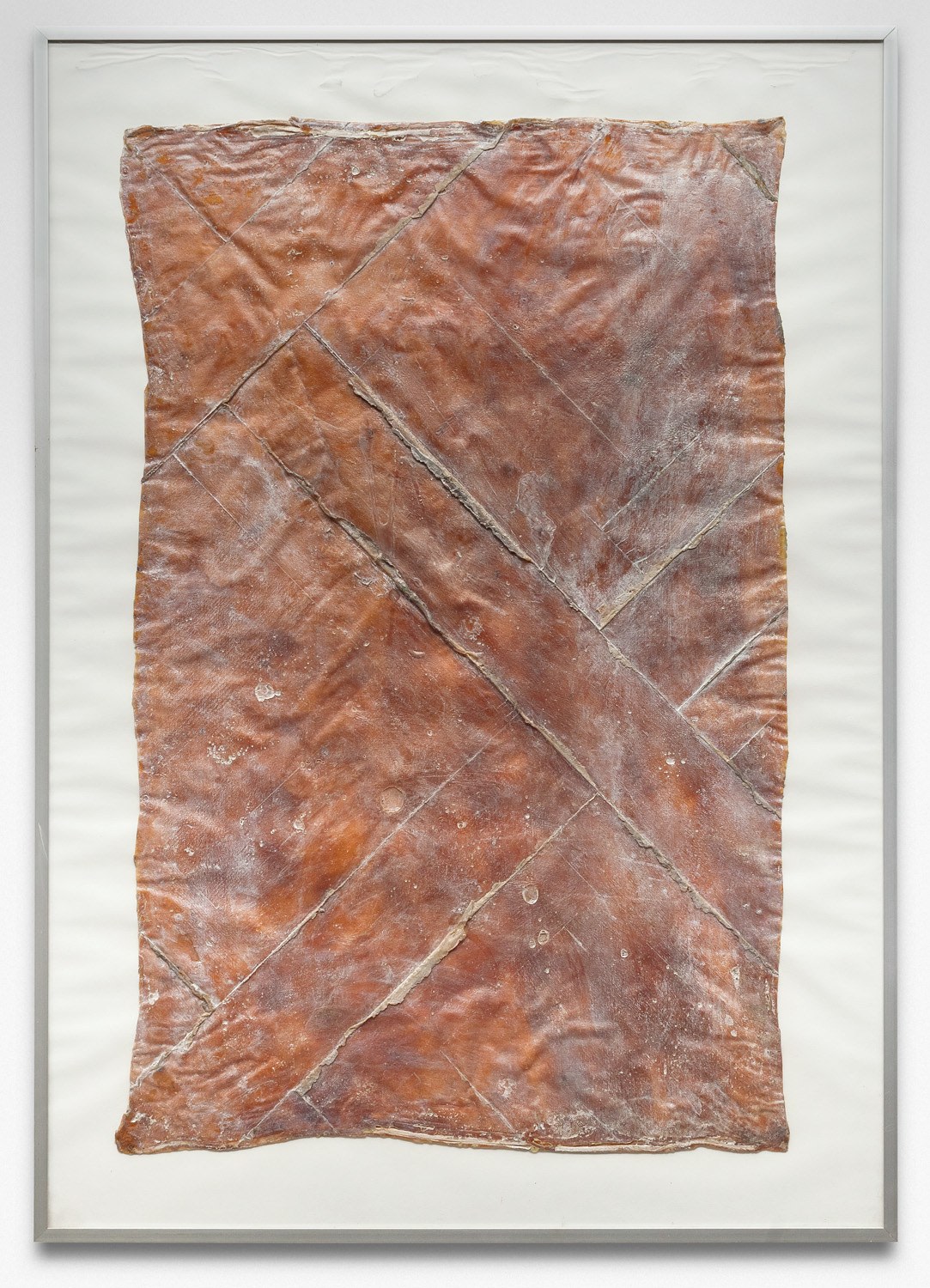Heidi Bucher (b. 1926, Winterthur, Switzerland; d. 1993, Brunnen, Switzerland) was a Swiss artist best remembered for her innovative use of latex and exploration of the physical boundaries between the body and its surroundings. Serving simultaneously as means of historical preservation and metaphorical molting, Bucher’s Hauträume—or “roomskins”—act as indexes of the complicated relationship humans have to their bodies and pasts. Working across the United States, Switzerland, and the Canary Islands, Bucher forged a practice anchored in familial, cultural, and architectural histories and deeply entwined with contemporary concerns around the boundaries between public and private space, and femininity and the body. Though Bucher’s many bodies of work—from her early drawings and wearable sculptures to her later latex-encased objects and Hauträume—each reflect distinct artistic interests and origins, they all trace back to the artist’s mantra, which uniquely summarizes her career-long engagement with bodies and rooms: Räume sind Hüllen, sind Häute (Spaces are shells, are skins).
Beginning in the 1970s, Bucher embalmed clothing in a mixture of latex and mother of pearl, preserving the objects as artifacts of their time and creating a surface that appeared skin-like in both color and texture. Bucher primarily used women’s clothing, such as nightdresses and pantyhose, as a critical response to the rigid gender restrictions she had experienced during her childhood and adolescence. By the end of the decade, Bucher began applying her signature latex medium to the surfaces of domestic objects and spaces, aligning women’s clothing with these designated “feminine” spaces. Allowing the latex mixture to harden, then peeling it off, Bucher produced translucent skins that held elements of paint, rust, dirt, and the minute details and markings of the architecture. During the years that followed, Bucher produced several major bodies of work based on the domestic spaces of her past—her ancestral house in Winterthur, the study in her parents’ home, and her studio in Zurich. Each space she inhabited was rendered translucent and ghostly, like a visual memory that, due to the fragile nature of the latex material, would warp and discolor over time. Displayed suspended mid-air, the series of latex Hauträume (Roomskins) are simultaneously monumental and fragile, mimicking the very process by which they are created; the removal of the latex from the architectural space required a great deal of both physical strength and delicate dexterity
Later in her career, Bucher expanded her practice to engage with public spaces, such as Swiss hotels, government offices, and mental health institutions. Today, her work exists in many surviving drawings, sculptures, and fragments, as well as in the photographs and videos which were often integral to the documentation and even creation of each body of latex works.
Bucher attended the School for Applied Arts in Zurich from 1942 to 1946, specializing in Fashion Design. Solo exhibitions of her work have been organized at the Parasol Unit, London (2018); the Swiss Institute of Contemporary Art, New York (2014); Centre Culturel Suisse, Paris (2013); Migros Museum für Gegenwartskunst, Zurich (2004); Kunstmuseum Thurgau, CH (1993); Los Angeles County Museum of Art, CA (1972); Musée d’Art Contemporain, Montréal, Canada (1971); and Museum of Contemporary Crafts, New York (1971) among others. Recent group exhibitions featuring her work include An Intricate Weave, Nottingham Contemporary, UK (2018); The Everywhere Studio, Institute of Contemporary Art, Miami, USA (2017); Women House, la Monnaie de Paris, Paris, France and National Museum of Women in the Arts, Washington D.C. (2017); Viva Arte Viva, 57th Venice Biennale, Italy (2017); No Place Like Home, Israel Museum, Jerusalem (2017); Room, Warwick Arts Centre, Warwick, UK (2017); and Artists and Architecture, Variable Dimensions, Pavillon de l’Arsenal, Paris, France (2015). Bucher’s work is featured in numerous international public and private collections, including the Hammer Museum, Los Angeles, USA; Centre Georges Pompidou, Paris, France; Kadist Art Foundation, Paris, France and San Francisco, CA; Metropolitan Museum of Art, New York; Migros Museum für Gegenwartskunst, Zurich, Switzerland; Musée Jenisch Vevey, Switzerland; and Kunstmuseum Winterthur, Winterthur, Switzerland.
海蒂·布赫(Heidi Bucher)1926年出生於瑞士溫特圖爾,1942年至1946年在蘇黎世應用藝術學院就讀,專門從事時裝設計,1993年於瑞士布倫嫩逝世。她的創作主題主要涉及對公共建築和私人建築的討論,以及女性的精神氣質和身體的探討。作品多取材於女性服裝,通過創造性地運用乳膠使其表面呈現出皮膚的質感;之後她將這種藝術創作方法運用到家居物品和整棟房屋建築中,將它們與特定的“女性”空間聯系起來。近兩年,這位歷史上被低估的傑出女性藝術家得到了藝術界持續的認可與關註。
從七十年代起,布赫用乳膠和珍珠母熏制衣服,用以保留其手工制品的時代背景,並制作出類似皮膚的顏色和質感。布赫使用了大量的女性衣物,例如睡衣和絲襪,去批判她成長時經歷過的性別定型。七十年代末,布赫開始在家居物品和空間上加上她標志性的乳膠塗層,將女性衣物和所謂的「女性空間」並列。她撕掉硬化的乳膠塗層,在半透明的皮膚上拓印了建築物上的顏料、鐵銹、灰塵、和細微的印記。
往後的數年間,布赫繼續根據她過往的聚居空間制作大型作品,她的靈感來源包括她在溫特圖爾的祖屋、她父母的書房、以及她蘇黎世的工作室。這些空間猶如布赫的視覺記憶,而乳膠的特質則會令作品卷曲和褪色。「Hauträume (Roomskins) 」系列的作品陳列在半空,看起來巨大卻又脆弱,就像布赫同時以力量和克制制作它們的過程。布赫的作品亦有發展到公共空間中,包括瑞士的酒店、政府辦公室、和心理衛生機構。她現存的作品有畫作、雕塑、碎片,還有記錄她創作過程的照片和影片。
在1942到1946年間,布赫在蘇黎世的應用藝術學院修讀時裝設計。她曾在眾多美術館及博物館舉行個人展覽,包括英國倫敦Parasol Unit當代藝術基金會(2018年)、美國紐約瑞士當代藝術中心(2014年)、法國巴黎瑞士藝術中心(2013年)、瑞士蘇黎世米格羅斯當代藝術博物館(2014年)、瑞士圖爾高美術館(1993年)和美國紐約當代工藝博物館(1971年)。她亦曾參與多個群體展覽,包括英國諾丁漢當代藝術中心的「An Intricate Weave」(2018年)、美國邁阿密當代藝術學院的「The Everywhere Studio」(2017年)、法國巴黎錢幣博物館及美國華盛頓特區的國立女性藝術家博物館的「Women House」(2017年)、第57屆威尼斯雙年展「VIVA ARTE VIVA!」(2017年)、耶路撒冷以色列博物館的「No Place Like Home」(2017年)、英國沃裏克沃裏克藝術中心的「Room」(2017年)以及法國巴黎建築與都市規劃中心的「Artists and Architecture, Variable Dimensions」(2015年)。其作品可見於多個國際公營以及私人收藏,包括洛杉磯哈默博物館、巴黎杜皮蓬中心、巴黎和舊金山卡迪斯特藝術基金會、紐約大都會藝術博物館、瑞士蘇黎世米格羅斯當代藝術博物館、瑞士沃偉耶尼施美術館及瑞士溫特圖爾藝術博物館。

